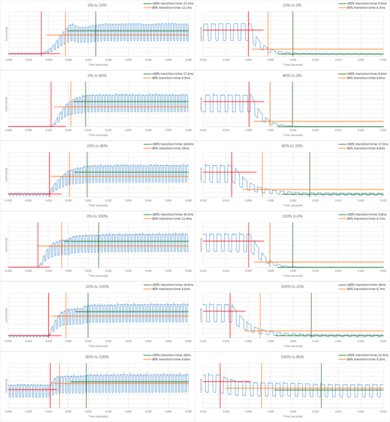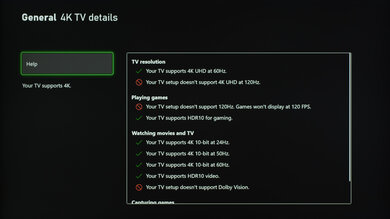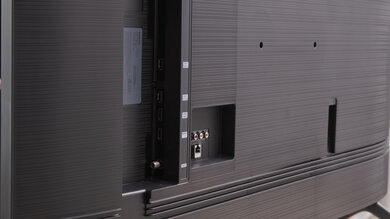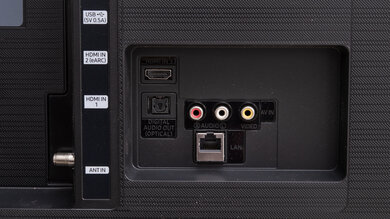The Samsung Q60/Q60T QLED, also sold as the Samsung Q6DT at Costco and Sam's Club, is an entry-level 4k QLED from Samsung's 2020 lineup. It's a decent all-around TV, although it lacks some features that you might find on higher-end models, like full-array local dimming or HDMI 2.1 bandwidth ports. It uses a VA panel with an outstanding contrast ratio and exceptional black uniformity, meaning it displays deep, uniform blacks in a dark room. Unfortunately, it has narrow viewing angles, so it's not as well-suited for a wide seating arrangement. It has remarkably low input lag, resulting in a responsive desktop and gaming experience. However, it doesn't support advanced gaming features, like variable refresh rate technology (VRR), and its response time is only passable, causing some motion blur in fast-moving scenes.
Our Verdict
The Samsung Q60T is a decent TV for most uses. It's good for watching TV during the day since it gets bright and has decent reflection handling. Despite lacking local dimming, it's still decent for watching movies in dark rooms thanks to its outstanding contrast ratio and remarkable black uniformity. It has a low input lag, so gaming feels responsive, but its slow response time makes motion look blurry. It's also a bit lacking for HDR, as it doesn't get bright enough to make highlights pop in HDR content.
- Outstanding contrast ratio.
- Gets bright enough to combat glare.
- Incredibly low input lag.
- No local dimming feature.
- No VRR support.
- Highlights don't pop in HDR.
The Samsung Q60T is decent for watching movies in a dark room. It looks good in a dark room thanks to its outstanding native contrast ratio and remarkable black uniformity, resulting in deep, uniform blacks. However, it doesn't have a local dimming feature to improve contrast. It upscales lower-resolution content from DVD or Blu-ray players well, and it can remove judder from native 24p sources, ensuring a smooth movie-watching experience.
- Outstanding contrast ratio.
- Remarkable black uniformity.
- No local dimming feature.
The Samsung Q60T is good for watching TV shows in a bright room. While its reflection handling is only decent, it gets bright enough to overcome glare in well-lit rooms. It also upscales lower resolution content from cable boxes without issue, and the Tizen smart interface has a great selection of streaming apps. Unfortunately, the image degrades when viewed at an angle, so it's not well-suited for a wide seating arrangement or if you like to move around with the TV on.
- Gets bright enough to combat glare.
- Decent reflection handling.
- Narrow viewing angles.
The Samsung Q60T is a decent TV for watching sports. It has great peak brightness in SDR and decent reflection handling, so it can easily overcome glare in a bright room. It also has good uniformity, with just a bit of dirty screen effect in the center of the screen. However, its response time is mediocre, so there's some motion blur with fast-moving content like sports. Unfortunately, it's not well suited for watching sports with a wide seating arrangement, as the image degrades when viewed at an angle.
- Gets bright enough to combat glare.
- No dirty screen effect.
- Narrow viewing angles.
- Motion looks blurry.
The Samsung Q60T is a decent TV for playing video games. It has remarkably low input lag, so gaming feels responsive. However, its response time is mediocre, so there's some motion blur behind fast-moving objects. It's great for gaming in the dark, thanks to its high contrast ratio and fantastic black uniformity. Unfortunately, it lacks advanced gaming features, like variable refresh rate support, and it doesn't support 4k @ 120Hz gaming.
- Outstanding contrast ratio.
- Remarkable black uniformity.
- Incredibly low input lag.
- Motion looks blurry.
- No VRR support.
The Samsung Q60T is decent for watching HDR movies. It displays a wide color gamut for HDR content, but it doesn't get bright enough for bright highlights to stand out. Its contrast ratio is outstanding, and it has remarkable black uniformity, so details in dark scenes look great, but there's no local dimming feature to further improve contrast. It supports HDR10 and HDR10+, but not Dolby Vision, so HDR content from some streaming sources will be limited to HDR10, which isn't as good.
- Outstanding contrast ratio.
- Displays a wide color gamut.
- No local dimming feature.
- Highlights don't pop in HDR.
The Samsung Q60T is decent for HDR gaming. Its low input lag makes for a responsive gaming experience, but it has a mediocre response time, so there's some motion blur. It displays a wide color gamut, but its HDR brightness is mediocre, so bright highlights don't stand out as well as they're supposed to. While it has an outstanding contrast ratio, it doesn't have a local dimming feature to improve contrast. Unfortunately, it lacks advanced gaming features, like variable refresh rate support, and it doesn't support 4k @ 120Hz gaming.
- Outstanding contrast ratio.
- Incredibly low input lag.
- Displays a wide color gamut.
- Motion looks blurry.
- No VRR support.
- Highlights don't pop in HDR.
The Samsung Q60T is a decent choice for a PC monitor. It has a remarkably low input lag, and it displays chroma 4:4:4 properly at any resolution, which is necessary for clear text. It's bright enough to combat glare and has decent reflection handling. Unfortunately, it has narrow viewing angles, so the edges of the screen look washed out if you sit too close. It also has a mediocre response time, resulting in some noticeable blur in fast-moving content.
- Incredibly low input lag.
- Displays chroma 4:4:4 properly.
- Narrow viewing angles.
- Motion looks blurry.
Changelog
- Updated Sep 26, 2025: We uploaded the latest brightness measurements and uniformity photos for the Accelerated Longevity Test.
- Updated Jul 08, 2025: We uploaded the latest brightness measurements and uniformity photos for the Accelerated Longevity Test.
- Updated Apr 17, 2025: We uploaded the latest brightness measurements and uniformity photos for the Accelerated Longevity Test.
- Updated Feb 11, 2025: We uploaded the latest brightness measurements and uniformity photos for the Accelerated Longevity Test.
Check Price
Differences Between Sizes And Variants
We tested the 55 inch Samsung Q60T, but the results are valid for the other sizes available, which you can see in the table below. You can find it sold as the Q6DT at warehouse stores, and the 70 inch model is only sold at Costco in the U.S. Note that with Samsung TVs, the five letters after the short model code (AFXZA in this case) can vary between regions and even between different retailers.
| Size | US Model | Short Model Code |
|---|---|---|
| 43" | QN43Q60TAFXZA | QN43Q60T |
| 50" | QN50Q60TAFXZA | QN50Q60T |
| 55" | QN55Q60TAFXZA | QN55Q60T |
| 58" | QN58Q60TAFXZA | QN58Q60T |
| 65" | QN65Q60TAFXZA | QN65Q60T |
| 70" | QN70Q6DTAFXZA | QN70Q6DT |
| 75" | QN75Q60TAFXZA | QN75Q60T |
| 82" | QN82Q60TAFXZA | QN82Q60T |
| 85" | QN85Q60TAFXZA | QN85Q60T |
If someone comes across a different type of panel or their Samsung Q60T doesn't correspond to our review, let us know and we'll update the review.
Our unit was manufactured in February 2020; you can see the label here.
Popular TV Comparisons

The Samsung Q60T is the entry-level QLED TV for 2020. It's a bit of a step down from 2019's Samsung Q60/Q60R QLED, as some of the more high-end features like variable refresh rate are now only available on the Samsung Q70/Q70T QLED and higher.
It's a good entry-level TV if you still want to have a decent HDR experience, but there are better options available for cheaper, like the Hisense H8G. See our recommendations for the best TVs, the best 4k TVs, and the best QLED TVs.
The Samsung Q70T and the Samsung Q60T are very similar TVs in many respects. The main difference is that the Q70T has a faster response time and a higher refresh rate, so motion looks smoother. Also, the Q60T can't remove judder from every source, and it doesn't support VRR. Gradient handling on the Q60T isn't as good, but it has better color accuracy, which is great if you don't plan on calibrating your TV.
The Samsung Q60A is the Samsung Q60T's successor and is nearly identical in terms of performance and features. There are some minor improvements to the color gamut and response time on the Q60A, but it has a noticeably lower contrast ratio than the Q60T. Other than that, the Q60A is much thinner, and its remote control has changed slightly to include an internal battery, which you can charge via the solar panel on the back or through a USB-C connection.
The Samsung Q80T is higher-end than the Samsung Q60T and has much better performance. The Q80T has a local dimming feature that improves its contrast, and it has Samsung 'Ultra Viewing Angle' technology that improves the viewing angles. The Q80T also has VRR support and a much quicker response time for a better gaming experience. However, because the Q60T doesn't have an 'Ultra Viewing Angle' layer, it has a much better native contrast ratio.
The Samsung Q60R is slightly better than the Samsung Q60T. Although the Q60T has some improvements in terms of performance, some features that were on the Q60R have been removed, such as 24p judder reduction and variable refresh rate. However, the Q60T's contrast ratio is a bit better, and it has much better uniformity, though response time is not as good as the Q60R.

We buy and test dozens of TVs yearly, taking an objective, data-driven approach to deliver results you can trust. Our testing process is complex, with hundreds of individual tests that take over a week to complete. Most of our tests are done with specially designed test patterns that mimic real content, but we also use the same sources you have at home to ensure our results match the real-world experience. We use two main tools for our testing: a Colorimetry Research CR-100 colorimeter and a CR-250 spectroradiometer.
Test Results

This TV looks more like a premium TV than an entry-level model. It has a borderless design with a thicker bottom bezel. The stand has been redesigned compared to the Samsung Q60/Q60R QLED. The overall look is sleek and minimalist, and it comes with clips for cable management.
The back of the TV is plastic with a textured finish. It comes with clips for cable management that attach to the feet, but we lost ours. The most commonly-used inputs face to the side and are easy to access, but some face to the back and are difficult to access.
This TV has a great SDR peak brightness. It's bright enough to combat glare in well-lit environments. There's very little variation in brightness with different scenes, but it's noticeably dimmer when displaying small highlights in dark scenes. The cause of this is the TV's frame dimming feature (also known as CE dimming or global dimming).
These measurements are from after calibration in the 'Movie' Picture Mode with Gamma set to '2.2', Contrast Enhancer off, and Brightness at its max. These are the brightest possible settings, as well as the most accurate.
This TV doesn't have a local dimming feature. We still film these videos on the TV, so you can see how the backlight performs and compare it with a TV that has local dimming.
There's no local dimming feature on this TV. We still film these videos on the TV, though, so you can see how the backlight performs and compare it with a TV that has local dimming.
The Samsung Q60T has mediocre peak brightness in HDR, and it doesn't get much brighter than in SDR. Once again, small highlights in an otherwise dark scene, like a street lamp in a dark alley, are significantly dimmer than other scenes. The peak brightness tracks the EOTF very well, so most scenes are displayed at the brightness level the content creator intended. There's a smooth roll-off near the TV's peak brightness, preserving fine details in bright scenes.
These measurements are from the 'Movie' Picture Mode with Contrast and Brightness at their max and ST.2084 set to '0'. These are the brightest and the most accurate settings.
The peak brightness in HDR in 'Game' mode is slightly worse than out of it. The peak brightness is slightly lower, and small bright scenes are even dimmer than before. The EOTF doesn't track correctly in 'Game' mode, as all scenes are dimmer than the content creator intended. The roll-off isn't as smooth as before, and fine details in bright scenes are washed out.
This TV has just good gray uniformity overall. The sides of the screen are darker than the center. There's very little dirty screen effect in the center of the screen, which is great for watching sports or using it as a PC monitor. It's a bit better in near-dark scenes, but there are still some distracting uniformity issues.
Unfortunately, the Samsung Q60/Q60T QLED has a disappointing viewing angle. The image fades, and colors shift noticeably as you move off-center, so this isn't a good TV for a wide seating arrangement or if you like to move around with the TV on.
This TV has decent reflection handling. The semi-gloss finish reduces the intensity of direct reflections a bit, but it can still overcome glare in well-lit rooms thanks to its relatively high peak brightness.
Out of the box, the Samsung Q60T has impressive accuracy. There are some inaccuracies with shades of gray and some colors, though they're difficult to spot. Gamma doesn't follow the curve, and most scenes appear brighter than they should. With Color Temperature set to 'Warm 2', it's a bit warmer than the calibration target of 6500K, resulting in a slightly reddish tint, but this isn't very noticeable.
After calibration, color accuracy is incredible. Any remaining inaccuracies aren't noticeable to the naked eye. White balance is virtually perfect, and gamma follows the curve well, so most scenes appear at the correct brightness. There are still some inaccuracies with blue, though that's typical of LED TVs.
You can see the recommended settings here.
This TV uses a BGR sub-pixel layout, which negatively affects the way text renders when using the TV as a PC monitor. You can read more about it here.
The Samsung Q60T has a good color gamut, with excellent coverage of the commonly-used DCI P3 color space. Colors look vivid and life-like with the majority of current HDR content. Its limited coverage of Rec. 2020 means it's not very future-proof, as more and more content will eventually switch to that color space.
The Samsung Q60T has an okay color volume. It displays dark, saturated colors well due to its high contrast ratio. It struggles a bit with brighter colors, which aren't as bright as pure white.
This TV has good gradient handling. There's some banding in almost all colors, but blues aren't as bad. It's especially noticeable in large areas of similar color, like shots of the sky. Setting Noise Reduction to 'Auto' helps a bit with low-quality content, but it can't completely smooth out banding.
We don't expect VA panels to experience permanent image retention, as the VA panel in our long-term test appears immune.
Unfortunately, this TV has a mediocre response time. There's some blur trail in fast-moving scenes, and there's some overshoot in the 0-20% transition, which causes some artifacts in dark scenes. The TV's flicker causes duplications in motion as well. If you're looking for a TV with a faster response time, check out the Samsung TU8000.
This TV uses pulse-width modulation (PWM) to dim the backlight, and there's flicker at all brightness levels. However, the frequency drops to 120Hz if the Picture Mode is set to Game, Dynamic, Standard, or Natural. Enabling Picture Clarity also changes the flicker frequency to 120Hz, even if you don't adjust the Judder Reduction slider. This low flicker frequency causes noticeable duplications in motion, and it can cause headaches and eye strain if you're sensitive to flicker.
There's an optional backlight strobing feature, commonly known as black frame insertion, designed to reduce the appearance of persistence blur. Unfortunately, with this feature enabled, it always flickers at 60Hz, and its timing is off, resulting in image duplication, similar to the Samsung RU7100.
There's a motion interpolation feature on this TV to make lower frame rate content look smoother. When enabled, it causes the backlight's flicker frequency to drop to 120Hz, which results in noticeable image duplication. Like most TVs, it sometimes struggles to keep up and stops interpolating altogether in busy scenes, and in medium-to-fast scenes, there are visible artifacts.
Due to the slow response time, there's barely any stutter in lower frame rate content.
This TV removes judder from native 24p sources, like Blu-ray players, as long as Picture Clarity is disabled. It can't remove judder from 60Hz sources, like a cable box.
Unlike its predecessor, the Samsung Q60/Q60R QLED, the Samsung Q60T doesn't support any variable refresh rate technology. If you want a 2020 TV with VRR support, check out the Samsung Q70/Q70T QLED.
This TV has remarkably low input lag at all resolutions as long as you're in 'Game' mode. It's too high for competitive gaming when using Game Motion Plus, but it's low enough for games that don't require fast reflexes, like turn-based RPGs or strategy games.
This TV supports most common resolutions at 60Hz. It displays proper chroma 4:4:4, which is important for reading text if you want to use it as a PC. To do so, change the icon for the HDMI input you're using to 'PC'.
This TV is a bit limited for PS5 or Xbox Series X gaming. It doesn't support high-frame-rate gaming, and it doesn't support any advanced gaming features, like variable refresh rate technology. There's an Auto Low Latency Mode; this turns on 'Game' mode automatically when the TV detects a game launching from a compatible gaming console like the Xbox Series X.
This TV has eARC support, allowing you to send high-quality audio, like Dolby Atmos via TrueHD, to a compatible receiver over an HDMI connection. Set HDMI eARC to 'Auto' and Digital Output Audio to 'Auto' or 'Passthrough'. Sadly, it doesn't support any DTS formats, which is disappointing, as many UHD Blu-rays use DTS for their lossless audio tracks.
This TV has an okay frequency response. It has a fairly well-balanced sound profile, so dialogue sounds good at moderate listening levels. It's decently loud, but it doesn't produce enough bass to get especially rumbly. There's no room correction feature to adjust the sound to your room's configuration.
The Samsung Q60T's distortion performance is mediocre. It's most significant in the bass range, but this is hardly noticeable as the TV can't produce much bass. It's not really noticeable in the vocal range, either, even at max volume. There's a bit more distortion at max volume, but it's not noticeable unless you have a well-trained ear.
Like all Samsung TVs, the Samsung Q60T runs on Tizen OS. It has been slightly redesigned with reduced features compared to the 2019 version, as the interface is now simpler and has a 'Dark Mode' instead of a white background.
Samsung's app store has a large number of apps, and they run smoothly for the most part. The built-in media player supports most common audio and video formats from a USB drive.
The remote for the Samsung Q60T remains relatively unchanged from the Samsung Q60/Q60R QLED. The Hulu button is now Samsung's TV Plus shortcut, and it also has the OneRemote feature, which lets you use the remote as a universal remote for other devices, even if they don't support CEC. There's a built-in microphone for voice control, which you can use to change inputs, launch apps, ask for information like the weather or time, or change certain settings; however, it can't search for specific content within an app like Netflix.



















































